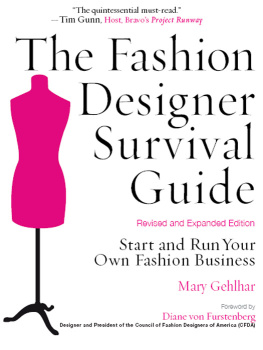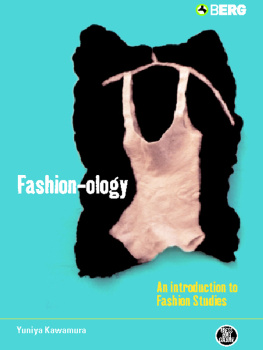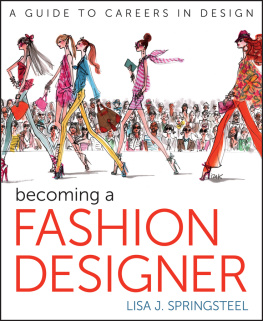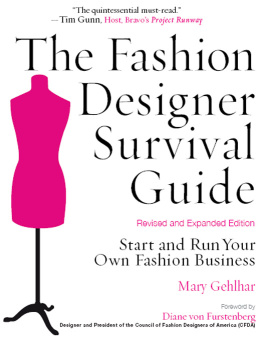Praise forThe Fashion Designer Survival Guide
Lest fashions neophytes get too dreamy, Gehlhar is there to ground them Womens Wear Daily
Mary presents many expectations [new designers] will confront in the marketplace and provides excellent professional advice throughout the book.Margaret Hayes, President, The Fashion Group International
Must readfind out from a pro who has worked with up-and-coming designers. New York Daily News
Every aspiring designer needs this book. Mary Gehlhar wrote an invaluable, step-by-step guide to succeeding on Seventh Avenue and beyond. Nancy MacDonell, News Editor, Style.com, and author of the Classic Ten: the True Story of the Little Black Dress andNine Other Fashion Favorites
For anyone whos ever aspired to be an independent designer, this is the book to pick up. the Daily
Ms. Gehlhar to the rescue! Who better to school fashion young uns on the ins and outs of the business than the woman who does just that for a living? Fashion Wire Daily
A must-read for anyone in the world of fashion. Gehlhar offers practical tips and strategies to increase chances of success. Soma Magazine
this book encourages all aspiring designers ready to embark on an independent career within the industry. Rebecca Taylor, designer
 | The Fashion
Designer
Survival
Guide
Revised and Expanded Edition
Start and Run Your
Own fashion Business
Mary Gehlhar |
 |
Contents

When I began my business in 1972, I wish a book like The Fashion DesignersSurvival Guide had existed that I could have turned to for advice on how to launch a fashion business. Fortunately, Mary Gehlhar has provided such an invaluable tool for todays generation of designers. Reading this guide brought me back to my first days as a designer and my own journey.
New designers often ask me what the key to success is when starting a business in fashion. My response is simple: you must first understand who or what you want to be. What is your vision? For whom are you designing clothes? It may take several months to figure this out, but once you do, the rest should come naturally.
Secondly, work with an experienced designer. Many of todays most successful designers worked as apprentices or assistants to established designers, which serves as a great opportunity for gaining exposure to the business of fashion and establishing industry contacts with suppliers, factories, editors, and retailers. I, myself, worked in a printing factory in Italy before I decided to design and launch my dresses.
Finally, never hesitate to seek help. Organizations such as the Council of Fashion Designers of America (CFDA) off er support and assistance, scholarships to design students, mentoring of emerging talent through the CFDA/ Vogue Fashion Fund and other programs, and ongoing panels with industry experts on the business of fashion. The CFDA is committed to working hard on behalf of the fashion industry to help designers succeed. As president of the Council of Fashion Designers of America, I represent all designers, new and experienced, and believe in sharing all I have learned with emerging talent.
I leave you with this: a good designer must recognize that there will be ups and downs in ones career and must be prepared for constructive criticism by press, buyers, peers, and so on. Always remain confident yet grounded, embrace advice and criticism, learn from your mistakes, and do not hesitate to ask for help.
I did not know the mechanics of how to start a company, but I managed to do so because I was not afraid to ask. You should always ask and seek answers for what you do not know. Many of these answers lie within the pages of The FashionDesigners Survival Guide, a great resource for new and established designers.
Fear is not an optionGo for it!
Sincerely,
Diane von Furstenberg
This book was originally published in 2005 and now, three years later, the proposition of being an independent fashion designer is as exhilarating as ever. Few industries move as fast as fashion, and opportunity abounds as the competition increases and the playing field changes daily.
Driven by celebrity obsession, fashion television, and the Internet, fashion is in hot demand. New designers are benefiting from an increased interest by retailers, editors, stylists, and even investors wanting to discover fashions greatest new hidden talent and off er shoppers a diverse selection. Consumers are more interested in whats new than in big brands.
Economic forces are also at play. The deflation of the dollar against the euro is leading American buyers to cut their European purchases and seek new, U.S.-based sources, and Europe is becoming a viable market. Accessories are booming as consumers willingly invest in high-end bags and shoes that dont fluctuate with their weight. New markets are available to designers as mass marketing and low-end design gigs at large chains, such as Gap and Target, have gained acceptability.
At the same time, the market is more saturated, more sophisticated, and more challenging. Fashions increasing role as part of pop culture has put more pressure on designers to be a personality or star and to differentiate their products to compete against the inexpensive, trend-driven fast fashion from chains such as H&M. More celebrities are launching their own labels, scooping up shelf space and licensing opportunities. Stores are less loyal to their designers as they look over their shoulder to welcome the next new name with buzz. The jaded say that starting your own label is really just a short-term strategy to getting a high-profile design job at an established label.
At the end of day, there is still a great need and desire for true innovation and creativity mixed with strong business acumen.
Few resources are available to help prepare designers for having their own labels. Fashion school will teach you about patterns, draping, and trend forecasts. It can prepare you for a successful career as head designer and even off er classes on bookkeeping and business plans. But running your own business is another matter.
This book is designed to help new designers successfully set up and run a business, benefiting from the pitfalls, mistakes, and triumphs of other designers who are doing it themselves. This second edition includes new sections on financing and private equity, sales and cold calling, and partnerships and consulting opportunities; an update on the extensive efforts to protect fashion designs legally; photo examples for branding and product development; as well as extended sections of quotes from entrepreneurial designers who are in the trenches facing these challenges every day. Through the course of writing the book, Ive spoken with more than 100 designers and industry professionals about their specific areas of expertise. I have gained valuable insight from the innovative thinkers and great business minds who have generously shared their experiences. Among the buying offices, editorial departments, fabric mills, factories, and financial institutions, there is a passionate crowd rooting for the next generation of designers.
These pages will demystify the world of young designers and reveal the tough parts while providing the knowledge and tools to carry on. It is a collective summary of what it takes to survive. The advice is not sugar coated, and its not always what you want to hear. But knowledge is power and should not discourage you.
Next page










